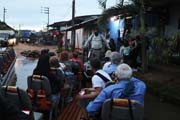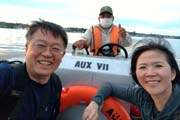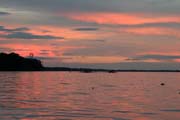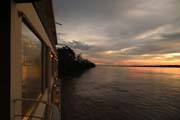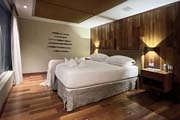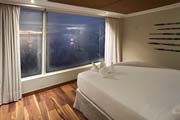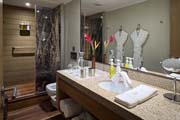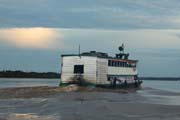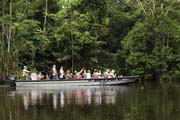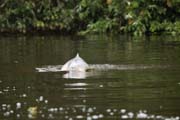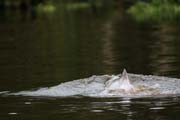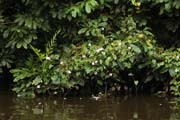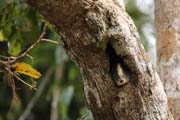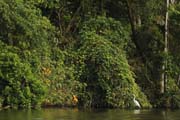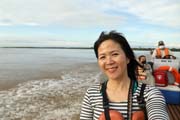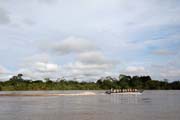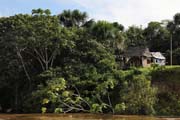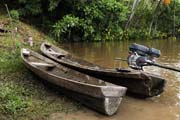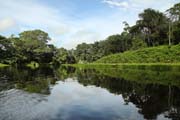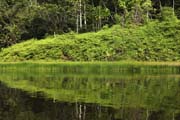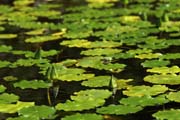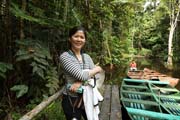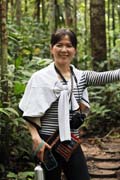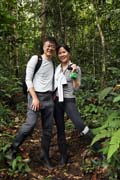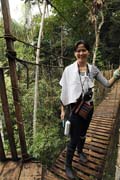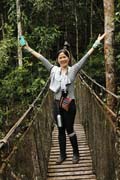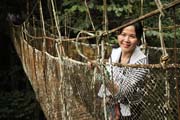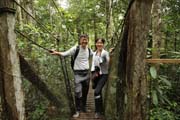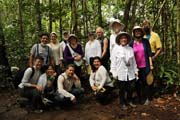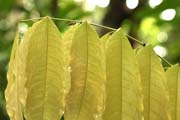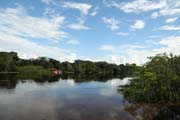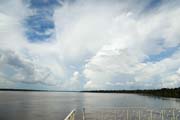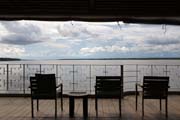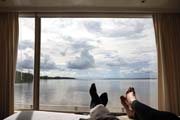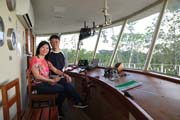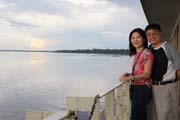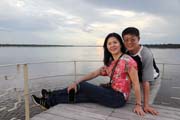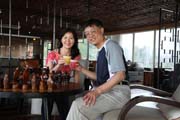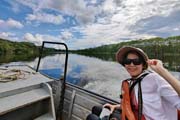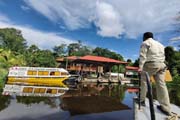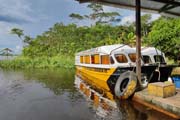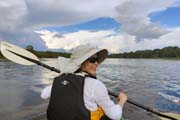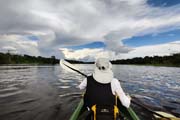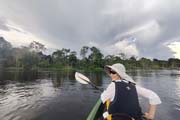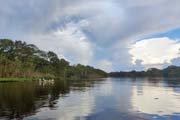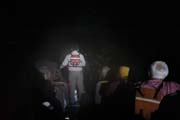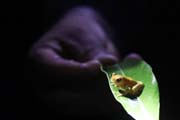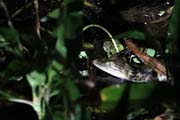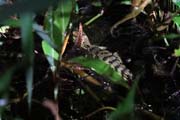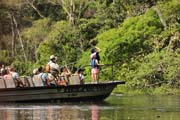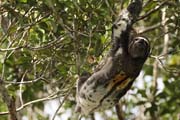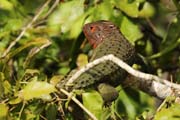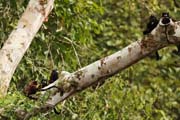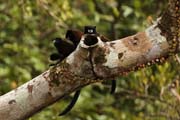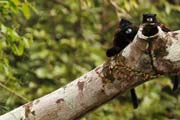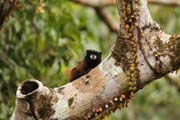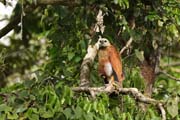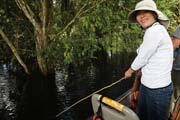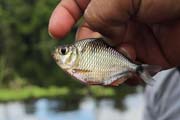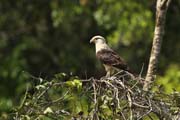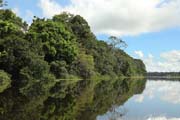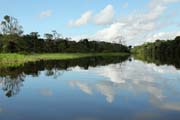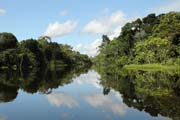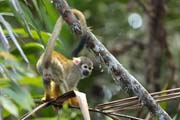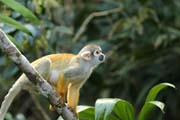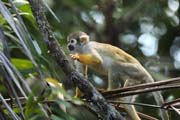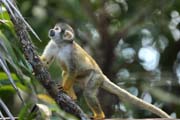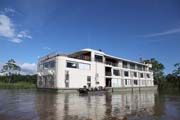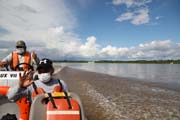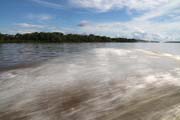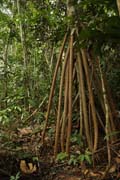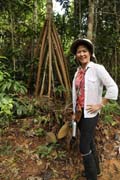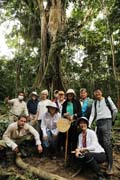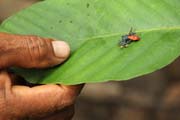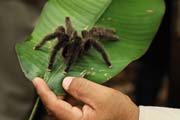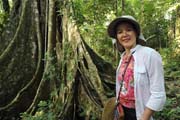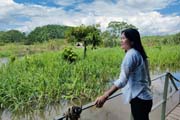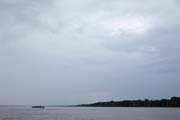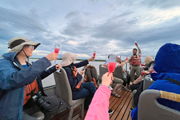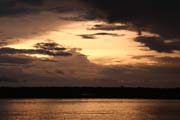Peru is a very diversified country with habitats ranging from the arid plains of
the Pacific coastal region in the west (where its capital city Lima is located)
to the peaks of the Andes mountains (where the various Inca ruins including
Machu Picchu were found) extending from the north to the southeast of the
country to the tropical Amazon basin rainforest in the east with the Amazon
River. Peruvian territory was home to several ancient cultures,
ranging from the Caral-Supe civilization starting in 3500 BCE, the oldest
civilization in the Americas, to the Inca Empire, the largest known state in
the pre-Columbian Americas. The Spanish Empire conquered the region in the
16th century and established a viceroyalty that encompassed most of its South
American territories. Peru formally proclaimed independence in 1821,
and completed its independence in 1824.
Getting there ...
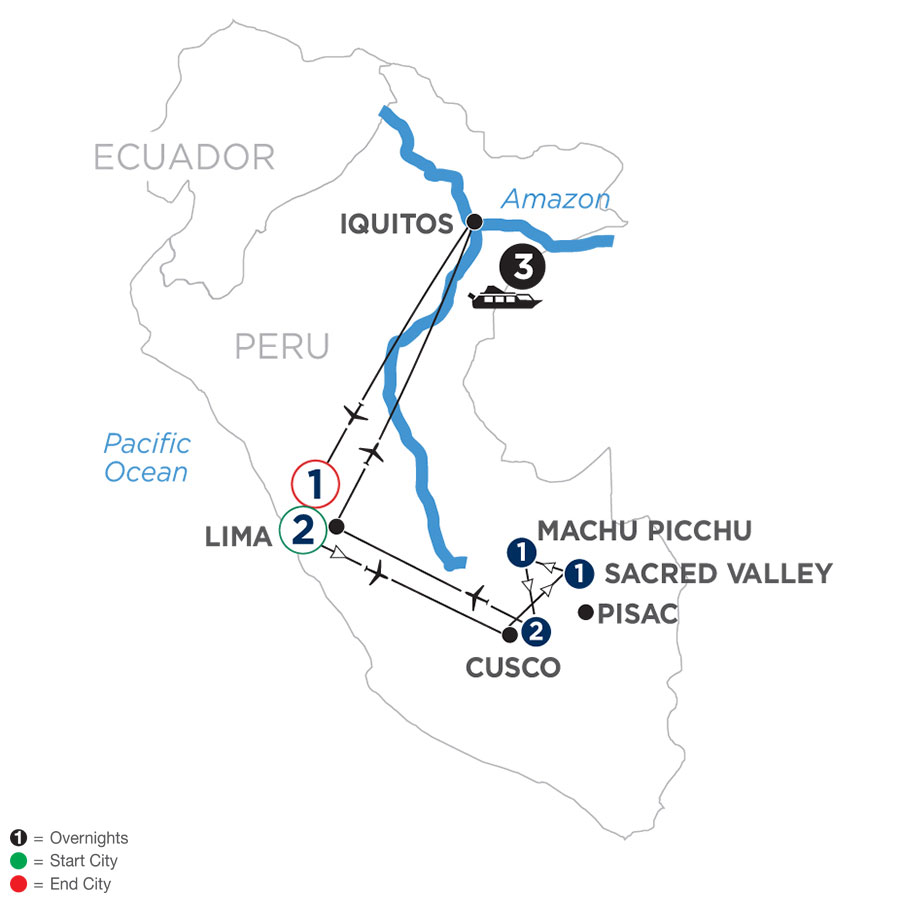 We joined
an
Avalon Waterway tour for this Peru trip which we will visit all three
regions in Peru: Lima in the Pacific coastal region; Cusco, Sacred Valley,
and Machu Picchu in the Andes mountains; and the Peruvian Amazon jungle in the
east. We had a morning flight on 4/30 from San Francisco with a
transfer in Houston, and arrived in Lima at late night ~ 10PM.
We joined
an
Avalon Waterway tour for this Peru trip which we will visit all three
regions in Peru: Lima in the Pacific coastal region; Cusco, Sacred Valley,
and Machu Picchu in the Andes mountains; and the Peruvian Amazon jungle in the
east. We had a morning flight on 4/30 from San Francisco with a
transfer in Houston, and arrived in Lima at late night ~ 10PM.
Day 2 (5/1) ...
- Miraflores, Lima
Miraflores is a residential and upscale shopping
district south of downtown Lima. It has several hotels (including ours),
restaurants, bars, nightclubs, and department stores.
- Parque del Amor (Park of Love)
Parque del Amor is a small park
dedicated to lovers that offers a panoramic view over the Pacific Ocean and
the cliffs of Lima. The curved, mosaic benches overlooking the ocean
really reminds me Gaudi's work in Barcelona (like
Park Güell).
It's a nice and relaxed walk to the lighthouse along the cliff’s edge with
fantastic views at every corner.
- Larcomar
Before getting to Larcomar, an indoor/outdoor, high-end
shopping mall built into the sea cliffs, we found a nice cliff side place
(Beso Francés, French Kiss) to have a late morning sweet crepe and coffee
while enjoy the incredible view. At Larcomar, Woanyu bought her
first souvenir for this trip: a baby Alpaca sweater.
- Indian Market
After lunch and a short break, we walked to the nearby
Indian Market, a traditional open-air market for souvenirs, antiques &
regional handicrafts. Since it was a holiday today (Labor Day), many
stalls were actually closed. It's OK for us because we did not intend
to buy anything anyway, and we just wanted to see what the market looks
like. After we were back to the hotel, we spent a nice late
afternoon in hotel's sauna and steam room.
Day 3 (5/2) ...
- Miraflores
The group tour started today. We met our guide Erika
and fellow travelers in the morning for a brief orientation, and then we had
more free time to have our own lunch (Woanyu's
first ceviche for this trip) around
the Kennedy Park in Miraflores.
- Alameda Chabuca Granda
We met at 2PM to start our first group tour
to Lima's historical downtown. We got off the bus and walked through
the park Alameda Chabuca Granda which is full of art works along the Rimac
River.
- Plaza de Armas, Lima
During the colonial era, Lima was one of the
most important cities in South America. This hub of trade and Catholicism
was the capital of the largest Spanish Viceroyalty in the region, and the
main square—Plaza de Armas—was the epicenter of it all. To this day, the
plaza houses the Government Palace (official workplace and residence
of Peru's president), the Cathedral (built during the 17th century, and home
to a rich collection valuable artwork), and the Municipal Palace.
There
was an on-going protest in Lima so there were police and fences everywhere
around the main square. The police did let us (e.g., foreign tourists
and some local people) pass through the gated area. Although we needed
to keep walking and could not wander around, we did get good and clean (no
crowds) photos in the Plaza.
- Basílica de San Francisco
Two blocks away from the main square is
this Baroque-style Roman Catholic church & monastery. The land for the
Convent was given to the Franciscan Order by Pizarro when the city was
founded in 1535. In 1655 an earthquake occurred in Lima that brought
down the original Franciscan Convent. The current Church and Convent
of San Francisco was consecrated in 1673 and completed in 1774. We
visited the catacombs underneath the church (no photo is allowed inside the
catacombs). It was operating as such until 1810 and it is estimated
that at that time it must have housed up to 70,000 people. It was
closed and then forgotten about until it was rediscovered and reopened in
1947. It was very impressive to see so many bones arranged in all
different patterns, but it was also quite dark and gloomy in the catacombs.
I have to admit that I felt relieved when we were back to the open fresh
air.
- Larco Museum
In 1926, at the age of 25, Rafael Larco Hoyle founded
the Museo Larco. Rafael Larco Hoyle was devoted to the study of ancient
Peru. He began his own scientific research and excavated at a number of
archaeological sites on Peru’s northern coast. Therefore, he is considered
one of the pioneers of Peruvian archaeology. Today, the museum is
housed in an 18th-century vice-royal building. It showcases chronological
galleries that provide a thorough overview of 5,000 years of Peruvian
pre-Columbian history.
Day 4 (5/3) ...
- Flight to Cusco
We had an early morning
flight to Cusco to start our exploration in the Andes. At the
elevation of 11,100 ft (3,400m), we started to feel the thin air effect on
our bodies during the day.
- Manos de la Comunidad
We visited this Llama/Alpaca/Guanaco place with
a textile shop where Woanyu bought her 2nd baby Alpaca sweater.
- Pisac
Pisac is situated on the Vilcanota River in the Sacred
Valley. It is most known for its Incan ruins and large market.
Our tour itinerary did not plan to visit any ruins around Pisac, so we spent
our time to walk around the old market and small streets.
By the time we arrived at the hotel in the Sacred Valley,
I had an extreme headache (from the high altitude response) and I had to skip
dinner to stay still in the bed.
Day 5 (5/4) ...
- Valle Sagrado Hotel and Villas
After a good night sleep, my headache
was gone and I was ready for the adventure to Machu Picchu today.
- Ollantaytambo (altitude of 2,792 m (9,160 ft))
Ollantaytambo is a
town and an Inca archaeological site about 72 km (45 mi) by road northwest
of the city of Cusco. During the Inca Empire, Ollantaytambo was the
royal estate of Emperor Pachacuti, who conquered the region, and built the
town and a ceremonial center. At the time of the Spanish conquest of Peru,
it served as a stronghold for Manco Inca Yupanqui, leader of the Inca
resistance. In 1536, on the plain of Mascabamba, near Ollantaytambo,
Manco Inca defeated a Spanish expedition, blocking their advance from a set
of high terraces and flooding the plain. In the fortress, we can find
six huge rectangular stone blocks (the largest monolith is over four meters
high and two meters wide) that belong to the Templo del Sol (Temple of the
Sun). They are located in one of the highest areas of the place and it seems
to be a construction that has been left unfinished.
- Inca Rail
We had a quick lunch before boarding the Inca Rail (the
360° Train) heading to Machu Picchu. It was a very scenic 1.5-hour
train ride (12:30PM to 2PM) through the valley along the Urubamba (or
Vilcamayo) River.
- Machu Picchu (altitude of 2,430 m (7,972 ft))
We got to Aguas Calientes, a small town at the foothill of Machu Picchu, at
around 2PM, and immediately headed toward the bus stop to catch the bus to
Machu Picchu.
Most recent archaeologists believe that Machu Picchu
was constructed as an estate for the Inca emperor Pachacuti (1438–1472).
Often referred to as the "Lost City of the Incas", it is the most familiar
icon of Inca civilization. The Incas built the estate around 1450 but
abandoned it a century later, at the time of the Spanish conquest.
Over the centuries, the surrounding jungle overgrew the site, and few
outside the immediate area knew of its existence.
In 1911 American
historian and explorer Hiram Bingham traveled the region looking for the old
Inca capital and was led to Machu Picchu by a villager, Melchor Arteaga.
Though Bingham was not the first to visit the ruins, he was considered the
scientific discoverer who brought Machu Picchu to international attention.
Bingham organized another expedition in 1912 to undertake major clearing and
excavation. Since the Incas had no written language, therefore, there
are no written records of the site while it was in use. The names of the
buildings, their supposed uses, and their inhabitants are all the product of
modern archeologists, on the basis of physical evidence, including tombs at
the site. Even the name "Machu Picchu" (can be interpreted as "Old
Mountain") was not the real name used by Incas.
The sky started to clear up when we began our tour in the
ruins. Considering there are 270 rainy days per year in Machu Picchu, we
were really lucky to see the Machu Picchu in one of the best afternoon light
conditions. Machu Picchu is really a majestic place. No pictures can
fully justify its grand beauty and mystery.
Day 6 (5/5) ...
-
Machu Picchu
We got up early and headed to Machu Picchu at 7AM for our
2nd visit to the mountain. Unfortunately it was a "typical" rainy day
in Machu Picchu that we could not even see the nearby mountains. It's
good for us to have a total different experience compared to yesterday.
- Aguas Calientes
We checked out our hotel room (after a nice shower as
we were all wet from the morning hike at Machu Picchu) before noon, and took
a leisured walk around the small town Aguas Calientes. We had a
late lunch at the hotel, and the hotel staff gave us a demo of making Pisco
Sour (aka Peru's national drink) and Ceviche.
- Cusco
After a long train and bus ride, we were back to Cusco at ~9PM.
After taking a few night shots around the hotel, we had a light dinner
(pizza) at the bar in the hotel.
Day 7 (5/6) ...
- Qorikancha
Qorikancha ("The Golden Temple") was the most important
temple in the Inca Empire. Originally named Intikancha or Intiwasi, it
was dedicated to Inti (the ancient Inca Sun God), and is located at the
former Inca capital of Cusco. Most of the temple was destroyed after the
16th-century war with the Spanish conquistadors, as settlers also took it
apart to build their own churches and residences. Much of its stonework was
used as the foundation for the seventeenth-century Santo Domingo Convent.
Major earthquakes severely damaged the church, but the Inca stone walls,
built out of huge, tightly interlocking blocks of stone, still stand due to
their sophisticated stone masonry.
- Qenco
Located at about 6 km north east of Cusco, Qenco is an
archaeological site as one of the largest huacas (holy places) in the Cusco
Region. Many huacas were based on naturally occurring rock formations. It
was believed to be a place where sacrifices and mummification took place.
- Saqsaywaman (altitude of 3,701 m (12,142 ft))
Saqsaywaman is a
citadel complex which was built by the Inca in the 15th century,
particularly under Pachacuti and successors. They built dry stone walls
constructed of huge stones. The workers carefully cut the boulders to fit
them together tightly without mortar. The pronunciation of "Saqsaywaman"
sounds exactly like "sexy woman" :-)
- Plaza de Armas, Cusco
Cusco was the capital and cultural heart of the
Inca Empire, with the city’s modern day Plaza de Armas serving as one of the
empire’s most important gathering spots. The Great Inca Square that
preceded Plaza de Armas was twice the size of the plaza today and was home
to regular meditation ceremonies. While the Spanish destroyed
native temples and buildings and replaced them with churches and mansions,
the site has remained an important hub of social, political, and religious
life for the people of Cusco.
We toured the Cathedral and the guide gave
us some interesting stories about its history and art, for example,
The Last Supper by a local Peruvian painter, presents Jesus and his
disciples dining on a guinea pig, a traditional Peruvian dish. After
the tour, we stayed on the main square and found a nice Ceviche restaurant
with a good view from its 2nd floor window table.
Day 8 (5/7) ...
- Peruvian Amazon
It was a long travel day:
early morning flight (left hotel at 5AM) from Cusco to Lima; long 4-hour
layover at a Lima airport hotel; 2-hour flight from Lima to Iquitos; 2-hour
bus ride to Nauta; a short skiff ride to embark our luxurious vessel, the
Delfin III, to start the Peruvian Amazon adventure.
Our Amazon exploration will be mainly in the Pacaya
Samiria National Reserve, the second largest protected natural area in Peru. It
protects an area of low hills and seasonally flooded forest in the Amazon
rainforest. It is a paradise for nature
lovers, with a biodiversity that includes more than 1000 species of animals and
965 species of wild plants.
Day 9 (5/8) ...
Here is the schedule for May
8.
- Morning Skiff Exploration at 6:00AM
- Night Excursion at 8:30PM
Day 10 (5/9) ...
Here is the schedule for May 9.
- Boat Ride Excursion and Fishing at 8:00AM
- Boat Ride to the Amazon Birthplace at 5:15PM
It started to rain when
we were back from the Jungle Walk. We decided to join the boat ride to
the confluence of Marañón River and Ucayali River, after which most
cartographers label the waterway the Amazon River. Although the
weather was not so good, we still had a nice champagne toast when we were at
the birthplace of Amazon!
Day 11 (5/10) ...
It's time to say farewell to Amazon. We disembarked the Delfin III at
7AM and visited the Manatee Rescue Center to learn about these endangered Amazon
species and the conservation efforts to save these gentle giants on the way to
Iquitos before flying to Lima. We were back to Lima and checked in
to the hotel at about 3PM, and had a relaxed free afternoon and a nice Peruvian
grill dinner.
Day 12 (5/11) ...
I booked a private Lima photo tour with
Andean Expeditions for our
last day in Lima, Peru. Dan (a French guy moved to Peru in 2016) is a very
nice guide with good photo and location knowledge, and showed us around the less
tourists but more photogenic neighborhoods in Lima.
- Callao & La Punta, Lima
Callao is a seaside city and Peru's
chief seaport and home to its main airport, Jorge Chávez International
Airport. The main neighborhoods of Callao is one of the current
cultural and artistic hubs of the port. Galleries and art exhibitions,
independent artist shops, concerts and open-air music festivals are part of
the cultural manifestations in this neighborhood.
- Barranco
Barranco has earned a reputation as the bohemian district of
Lima because of its bright buildings, beautiful street art, and charming
streets. Barranco has been home to some of Peru’s and Latin
America’s finest artists, offering them beauty and inspiration.
- Chorrillos Fisherman Harbor & Morro Solar
Chorrillos Fisherman
Harbor is a local active fisherman's market with fresh fish coming from the
small fishing boats all the time. I cannot imagine I could have so
much "fun" in a fish market (the mask help reduce the smell :-)).
Morro Solar is a cliffside headland overlooking the
Pacific Ocean in the southern district of Chorrillos. The expanse features
several statues and monuments, but the 120-foot statue of Jesus Christ (Christ
of the Pacific ) is probably best known for its scandal of corruption story...
- Plaza de Armas
We went to Plaza de Armas as our last stop of the
full-day tour. Dan took us to a rooftop bar for the golden and blue
hours. It was so nice to wait for the perfect timing with pisco sour
at hand :-)
Going Home ...
After a few more night pictures around the plaza, the driver took us to the
airport at about 7PM for our mid-night flight. Since it still required
COVID negative testing results to go back to US, we had COVID testing arranged
in the morning (by Avalon tour) in the hotel before we went out for the photo
tour. I was a little bit worry about the testing because I did feel
something weird in my throat in the morning. Luckily both Woanyu and I
were tested negative and we could check in our flight without any issue.
In fact, after we got home on Thursday (5/12) afternoon, I was tested positive
using a at-home test kit...
Peru is indeed a diversified country with people
so friendly. From Lima to high Andes mountains (Cusco and Machu Picchu) to
Amazon jungle, everywhere we went was so unique and so memorable.
[Back to Photo Page]
[Gallery]
 We joined
an
Avalon Waterway tour for this Peru trip which we will visit all three
regions in Peru: Lima in the Pacific coastal region; Cusco, Sacred Valley,
and Machu Picchu in the Andes mountains; and the Peruvian Amazon jungle in the
east. We had a morning flight on 4/30 from San Francisco with a
transfer in Houston, and arrived in Lima at late night ~ 10PM.
We joined
an
Avalon Waterway tour for this Peru trip which we will visit all three
regions in Peru: Lima in the Pacific coastal region; Cusco, Sacred Valley,
and Machu Picchu in the Andes mountains; and the Peruvian Amazon jungle in the
east. We had a morning flight on 4/30 from San Francisco with a
transfer in Houston, and arrived in Lima at late night ~ 10PM.